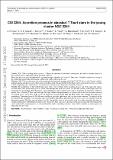Files in this item
CSI 2264 : accretion process in classical T Tauri stars in the young cluster NGC 2264
Item metadata
| dc.contributor.author | Sousa, A. P. | |
| dc.contributor.author | Alencar, S. H. P. | |
| dc.contributor.author | Bouvier, J. | |
| dc.contributor.author | Stauffer, J. | |
| dc.contributor.author | Venuti, L. | |
| dc.contributor.author | Hillenbrand, L. | |
| dc.contributor.author | Cody, A. M. | |
| dc.contributor.author | Teixeira, P. S. | |
| dc.contributor.author | Guimarães, M. M. | |
| dc.contributor.author | McGinnis, P. T. | |
| dc.contributor.author | Rebull, L. | |
| dc.contributor.author | Flaccomio, E. | |
| dc.contributor.author | Fürész, G. | |
| dc.contributor.author | Micela, G. | |
| dc.contributor.author | Gameiro, J. F. | |
| dc.date.accessioned | 2018-03-07T14:30:07Z | |
| dc.date.available | 2018-03-07T14:30:07Z | |
| dc.date.issued | 2016-02 | |
| dc.identifier | 251732278 | |
| dc.identifier | 75f7bd35-b397-48e9-8f4d-0baa4f82ea36 | |
| dc.identifier | 84956639235 | |
| dc.identifier.citation | Sousa , A P , Alencar , S H P , Bouvier , J , Stauffer , J , Venuti , L , Hillenbrand , L , Cody , A M , Teixeira , P S , Guimarães , M M , McGinnis , P T , Rebull , L , Flaccomio , E , Fürész , G , Micela , G & Gameiro , J F 2016 , ' CSI 2264 : accretion process in classical T Tauri stars in the young cluster NGC 2264 ' , Astronomy & Astrophysics , vol. 586 , A47 . https://doi.org/10.1051/0004-6361/201526599 | en |
| dc.identifier.issn | 0004-6361 | |
| dc.identifier.other | BibCode: 2016A&A...586A..47S | |
| dc.identifier.other | ORCID: /0000-0002-3665-5784/work/39714993 | |
| dc.identifier.uri | https://hdl.handle.net/10023/12871 | |
| dc.description | APS and SHPA acknowledge support from CNPq, CAPES and Fapemig. JFG acknowledges support from FCT ref project UID/FIS/04434/2013. | en |
| dc.description.abstract | Context. NGC 2264 is a young stellar cluster (~3 Myr) with hundreds of low-mass accreting stars that allow a detailed analysis of the accretion process taking place in the pre-main sequence. Aims. Our goal is to relate the photometric and spectroscopic variability of classical T Tauri stars to the physical processes acting in the stellar and circumstellar environment, within a few stellar radii from the star. Methods. NGC 2264 was the target of a multiwavelength observational campaign with CoRoT, MOST, Spitzer, and Chandra satellites and photometric and spectroscopic observations from the ground. We classified the CoRoT light curves of accreting systems according to their morphology and compared our classification to several accretion diagnostics and disk parameters. Results. The morphology of the CoRoT light curve reflects the evolution of the accretion process and of the inner disk region. Accretion burst stars present high mass-accretion rates and optically thick inner disks. AA Tau-like systems, whose light curves are dominated by circumstellar dust obscuration, show intermediate mass-accretion rates and are located in the transition of thick to anemic disks. Classical T Tauri stars with spot-like light curves correspond mostly to systems with a low mass-accretion rate and low mid-IR excess. About 30% of the classical T Tauri stars observed inthe 2008 and 2011 CoRoT runs changed their light-curve morphology.Transitions from AA Tau-like and spot-like to a periodic light curves and vice versa were common. The analysis of the Hα emission line variability of 58 accreting stars showed that 8 presented a periodicity that in a few cases was coincident with the photometric period. The blue and red wings of the Hα line profiles often do not correlate with each other, indicating that they are strongly influenced by different physical processes. Classical T Tauri stars have a dynamic stellar and circumstellar environment that can be explained by magnetospheric accretion and outflow models, including variations from stable to unstable accretion regimes on timescales of a few years. | |
| dc.format.extent | 31 | |
| dc.format.extent | 14334765 | |
| dc.language.iso | eng | |
| dc.relation.ispartof | Astronomy & Astrophysics | en |
| dc.rights | © ESO, 2016. This work has been made available online in accordance with the publisher’s policies. This is the author created, accepted version manuscript following peer review and may differ slightly from the final published version. The final published version of this work is available at https://doi.org/10.1051/0004-6361/201526599 | en |
| dc.subject | Stars: formation | en |
| dc.subject | Stars: variables: T Tauri | en |
| dc.subject | Herbig Ae/Be | en |
| dc.subject | Open clusters and associations: individual: NGC 2264 | en |
| dc.subject | Accretion | en |
| dc.subject | Accretion disks | en |
| dc.subject | QB Astronomy | en |
| dc.subject | QC Physics | en |
| dc.subject | DAS | en |
| dc.subject.lcc | QB | en |
| dc.subject.lcc | QC | en |
| dc.title | CSI 2264 : accretion process in classical T Tauri stars in the young cluster NGC 2264 | en |
| dc.type | Journal article | en |
| dc.contributor.institution | University of St Andrews.School of Physics and Astronomy | en |
| dc.identifier.doi | 10.1051/0004-6361/201526599 | |
| dc.description.status | Peer reviewed | en |
| dc.identifier.url | http://adsabs.harvard.edu/abs/2016A%26A...586A..47S | en |
This item appears in the following Collection(s)
Items in the St Andrews Research Repository are protected by copyright, with all rights reserved, unless otherwise indicated.

